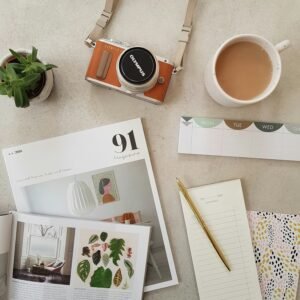How to Get Started with Concept Art

Anyone who ever marveled at intricate video game worlds, fantasy animated superheroes, and sci-fi film space ships must have been exposed to concept art. Concept art is a mix of planning and creativity and is the genesis of visual storytelling and inspiration for film, video game, and all forms of creative activity.
While it’s scary to start a concept art career, with a positive mindset, equipment, and training on your side, you can start today and build a strong creative portfolio that inspires people and leads to opportunities for you.
We’ll begin with concept art and how you can show your work through digital art portfolios, graphic design portfolios, and other art software.

🧠 Concept Art: What Is It?
An idea’s visual representation prior to its completion is known as concept art. Characters, settings, objects, ambiances, and designs are all displayed using it in the entertainment industry.
🎨 Concept art is not final artwork—it’s testing and redoing. It’s visual brainstorming.
From developing an entire world to choosing a hero’s weapon, the objective is to communicate ideas well and imaginatively.
🪄 Step 1: Understand the Principles of Visual Design
Let’s get the basics down first before we get to fancy tools or techniques. Concept art is based on sound design principles including:
- Shape language
- Perspective
- Composition
- Color theory
- Light and shadow
These are as important in a typography show, UI design portfolio, or branding samples as they are in concept art. If you learn the basics first, every piece you produce will be better.
✏️ Step 2: Learn to Draw—A Lot
Drawing is the basis of all concept art. You don’t have to be a wonderful painter on day one, but you must draw every day.
Try these daily drawing exercises:
- Historical figures
- Fantasy creatures
- Sci-fi or fantasy landscapes
- Vehicles and guns
- Facial expressions and anatomy studies
Keep a digital or physical sketchbook in your design thinking library. Don’t worry if it’s not perfect—practice is progress.
🔍 Step 3: Research Real Life and Pop Culture
Concept artists are visual problem solvers. They are motivated by the world and other artists.
To motivate design, do the following:
- Photograph architecture or landscapes
- Learn from historical artifacts for costume design
- Watch behind-the-scenes films
- Break down the design of your favorite video games
Use this research to inform your visual design examples and support your ideas.
🛠️ Step 4: Use Proper Tools
Most concept artists use digital tools such as:
- Adobe Photoshop
- Procreate
- Clip Studio Paint
- Blender (for 3D concepting)
A tablet (e.g., Wacom or iPad) will also render drawing digitally more professional and easy to use.
These packages allow you to create high-quality art that’s easy to integrate into your digital illustration portfolio or art collection.
🌍 Step 5: Begin a Personal Project
No doing without learning. Design your own small project from a background or setting.
Example Project: “Lost Planet”
- Concept 3 characters: scientist, explorer, villain
- Develop 2 environment concepts: research station, jungle planet
- Develop 3 props: hover car, alien relic, communications device
These will also provide you with fodder for your concept art section and can be incorporated as part of your graphic design portfolio, UI design portfolio, or even motion graphics examples if working on animation.
🗂️ Step 6: Build a Good Portfolio
Your portfolio includes:
- Completed artwork
- Process work (thumbnails, refinements, boards)
- A brief background story or description of each piece
You may display your work on:
- Behance for completed portfolios
- ArtStation for presentation-led concept art
- Dribbble for small images
- Your personal website as part of your web design portfolio
Remember to include your branding examples, logo design tests, or any freelance design work to showcase flexibility.
👨🏫 Step 7: Learn from the Expert
Concept artists love sharing speedpaints, breakdowns, and tutorials. Subscribe to popular artists on YouTube, Gumroad, or ArtStation.
🔥 Recommended Artists & Channels:
- FZD School (Feng Zhu)
- Sinix Design
- Marco Bucci
- Scott Robertson
Recreate their work and put your spin on it. These can even be submitted as work-in-progress features within your design portfolio.
🌐 Step 8: Be Part of Online Communities
Show your workflow, receive constructive criticism, and be inspired by being part of artist communities such as:
- Reddit’s r/ArtCrit or r/ConceptArt
- Discord art servers
- Online challenges (e.g., Character Design Challenge, Inktober)
These websites are ideal for sharing illustration portfolio pieces and discovering new design inspiration.
💼 Step 9: Freelance Project Acceptance
When ready, attempt freelance designer work. Even small projects make you do briefs, deadlines, and revisions like an actual concept artist.
Look for clients who need:
- Character or mascot design
- Environment backgrounds for indie games
- Concept boards for ads or animations
These types of projects are great portfolio pieces and show you as a problem solver, not just an artist.
🚀 Step 10: Keep on Evolving
Concept art is an evolving field. Technology improves, trends shift, and client requirements grow. Stay one step ahead with:
- Online courses (Skillshare, Domestika, etc.)
- Staying current with design trends in your UX design presentation or UI design portfolio
- Participating in theme typography exhibitions or imagination challenges
The secret to lasting success is keeping a questioning mind and continuously improving.
🎯 Final Thoughts
It takes passion, research, discipline, and creativity to start working with concept art. Concept art gives you a chance to bring your ideas into existence and have the world view them, be it future technology, alien worlds, or heroic heroes.
You are halfway being a concept artist if you already possess a good creative portfolio, sketch on a regular basis, and utilize the proper channels in promoting your artwork, i.e., a nicely designed digital art presentation or an updated online portfolio.
Share:
More Posts

Best Free Online Galleries for Artists
Every artist today must possess a strong web presence. Having an exhibition featured in an online art gallery is among the best methods through which

What Makes a Great Creative Blog?
In the fast-changing world of design, art, and digital imagination today, a creative blog is not a hobbyist pursuit—it’s a tool for self-expression, career development,

Daily Art Prompts to Spark Creativity
All creatives are guilty of that terrible moment of standing before the blank canvas, the blank sketchbook, or the blank screen with no idea where

Creating a Digital Portfolio That Gets Noticed
A robust web presence is necessary in order to thrive in this rapidly moving, very visual art community. Your website must have a strong message

